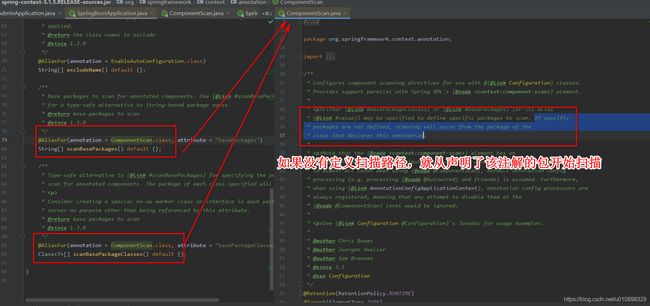springboot学习笔记--@SpringBootApplication
目录
0.关于@SpringBootApplication的源码
1.为何将application.calss置于项目的根目录下
2.@SpringBootApplication注解的主要作用
3.application.class文件放置其他目录的配置方法
使用IDEA生成springboot项目的时候,会为我们生成一个根目录下的xxxxApilcation.class文件,然后在这个application.calss中会有一个main方法,我们只要运行这个main方法项目就可以跑起来了,那么不知道有没有人注意到这个application上面的注解@SpringBootApplication,我稍微研究了下这个注解,在这里做个记录。
写到这里呢,先抛出一连串的问题,这篇文章呢也是围绕这些问题来写的:
- 为什么我们的 xxxAplication.class文件要放在项目的跟目录下,而且要加上@SpringBootApplication注解?
- @SpringBootApplication注解的主要作用是什么?
- 这个 application.calss 可不可以放到其他的目录中,要如何配置?
0.关于@SpringBootApplication的源码
先打开源码看看,这个注解的内容
package org.springframework.boot.autoconfigure;
import java.lang.annotation.Documented;
import java.lang.annotation.ElementType;
import java.lang.annotation.Inherited;
import java.lang.annotation.Retention;
import java.lang.annotation.RetentionPolicy;
import java.lang.annotation.Target;
import org.springframework.boot.SpringBootConfiguration;
import org.springframework.boot.context.TypeExcludeFilter;
import org.springframework.context.annotation.Bean;
import org.springframework.context.annotation.ComponentScan;
import org.springframework.context.annotation.ComponentScan.Filter;
import org.springframework.context.annotation.Configuration;
import org.springframework.context.annotation.FilterType;
import org.springframework.core.annotation.AliasFor;
/**
* Indicates a {@link Configuration configuration} class that declares one or more
* {@link Bean @Bean} methods and also triggers {@link EnableAutoConfiguration
* auto-configuration} and {@link ComponentScan component scanning}. This is a convenience
* annotation that is equivalent to declaring {@code @Configuration},
* {@code @EnableAutoConfiguration} and {@code @ComponentScan}.
*
* @author Phillip Webb
* @author Stephane Nicoll
* @since 1.2.0
*/
@Target(ElementType.TYPE)
@Retention(RetentionPolicy.RUNTIME)
@Documented
@Inherited
@SpringBootConfiguration
@EnableAutoConfiguration
@ComponentScan(excludeFilters = {
@Filter(type = FilterType.CUSTOM, classes = TypeExcludeFilter.class),
@Filter(type = FilterType.CUSTOM, classes = AutoConfigurationExcludeFilter.class) })
public @interface SpringBootApplication {
/**
* Exclude specific auto-configuration classes such that they will never be applied.
* @return the classes to exclude
*/
@AliasFor(annotation = EnableAutoConfiguration.class)
Class[] exclude() default {};
/**
* Exclude specific auto-configuration class names such that they will never be
* applied.
* @return the class names to exclude
* @since 1.3.0
*/
@AliasFor(annotation = EnableAutoConfiguration.class)
String[] excludeName() default {};
/**
* Base packages to scan for annotated components. Use {@link #scanBasePackageClasses}
* for a type-safe alternative to String-based package names.
* @return base packages to scan
* @since 1.3.0
*/
@AliasFor(annotation = ComponentScan.class, attribute = "basePackages")
String[] scanBasePackages() default {};
/**
* Type-safe alternative to {@link #scanBasePackages} for specifying the packages to
* scan for annotated components. The package of each class specified will be scanned.
*
* Consider creating a special no-op marker class or interface in each package that
* serves no purpose other than being referenced by this attribute.
* @return base packages to scan
* @since 1.3.0
*/
@AliasFor(annotation = ComponentScan.class, attribute = "basePackageClasses")
Class[] scanBasePackageClasses() default {};
}
从注释里面可以看到@SpringBootApplication这个注解相当于下面三个的合体
- @Configuration -- 声明为配置文件
- @EnableAutoConfiguration -- 声明自动配置
- @ComponentScan -- 组件扫描
围绕着源码,我们来一一解答上面的三个问题。
1.为何将application.calss置于项目的根目录下
为application.class文件声明了@SpringBootApplication注解就包含了声明了组件扫描的注解@ComponentScan,我们打开看下组件扫描的注解
看注释中有说明,如果我们没有定义包扫描的路径,就会自动从使用了改注解的包开始扫描起,也就是会从我们的项目根目录往下扫描,因此我们一般在跟目录之下会再放几个包 类似 dao , service , controller,config,entity等,那么这些也会被自动扫描。扫描之后就会装载到spring的容器中去。
其实将application.class加上@SpringBootApplication注解文件并且放在项目的根目录下,无论使用还是项目架构上都会方便很多,不然的话,我们还需要一一指定包扫描路径,如下
@SpringBootApplication(scanBasePackages = {"com.cjt.demo.controller","com.cjt.demo.service"})2.@SpringBootApplication注解的主要作用
@SpringBootApplication注解的主要作用其实就是他所包含的三个注解的功能,如果不使用这个注解,那么在application.class启动类上,我们要分别加上@Configuration、@EnableAutoConfiguration、@ComponentScan这三个注解。
@ComponentScan这个是包扫描的注解,主要作用就是将所有组件在初始化的时候注入到Spring容器中,让spring进行管理,例如我们常用的@Controller @Service @Autowired等注解,如果没有被扫描加载到容器中被spring管理,那么使用这些注解都是无效的。
关于@EnableAutoConfiguration可以稍微看下源码的注释
package org.springframework.boot.autoconfigure;
import java.lang.annotation.Documented;
import java.lang.annotation.ElementType;
import java.lang.annotation.Inherited;
import java.lang.annotation.Retention;
import java.lang.annotation.RetentionPolicy;
import java.lang.annotation.Target;
import org.springframework.boot.autoconfigure.condition.ConditionalOnBean;
import org.springframework.boot.autoconfigure.condition.ConditionalOnClass;
import org.springframework.boot.autoconfigure.condition.ConditionalOnMissingBean;
import org.springframework.boot.web.embedded.tomcat.TomcatServletWebServerFactory;
import org.springframework.boot.web.servlet.server.ServletWebServerFactory;
import org.springframework.context.annotation.Conditional;
import org.springframework.context.annotation.Configuration;
import org.springframework.context.annotation.Import;
import org.springframework.core.io.support.SpringFactoriesLoader;
/**
* Enable auto-configuration of the Spring Application Context, attempting to guess and
* configure beans that you are likely to need. Auto-configuration classes are usually
* applied based on your classpath and what beans you have defined. For example, if you
* have {@code tomcat-embedded.jar} on your classpath you are likely to want a
* {@link TomcatServletWebServerFactory} (unless you have defined your own
* {@link ServletWebServerFactory} bean).
*
* When using {@link SpringBootApplication}, the auto-configuration of the context is
* automatically enabled and adding this annotation has therefore no additional effect.
*
* Auto-configuration tries to be as intelligent as possible and will back-away as you
* define more of your own configuration. You can always manually {@link #exclude()} any
* configuration that you never want to apply (use {@link #excludeName()} if you don't
* have access to them). You can also exclude them via the
* {@code spring.autoconfigure.exclude} property. Auto-configuration is always applied
* after user-defined beans have been registered.
*
* The package of the class that is annotated with {@code @EnableAutoConfiguration},
* usually via {@code @SpringBootApplication}, has specific significance and is often used
* as a 'default'. For example, it will be used when scanning for {@code @Entity} classes.
* It is generally recommended that you place {@code @EnableAutoConfiguration} (if you're
* not using {@code @SpringBootApplication}) in a root package so that all sub-packages
* and classes can be searched.
*
* Auto-configuration classes are regular Spring {@link Configuration} beans. They are
* located using the {@link SpringFactoriesLoader} mechanism (keyed against this class).
* Generally auto-configuration beans are {@link Conditional @Conditional} beans (most
* often using {@link ConditionalOnClass @ConditionalOnClass} and
* {@link ConditionalOnMissingBean @ConditionalOnMissingBean} annotations).
*
* @author Phillip Webb
* @author Stephane Nicoll
* @see ConditionalOnBean
* @see ConditionalOnMissingBean
* @see ConditionalOnClass
* @see AutoConfigureAfter
* @see SpringBootApplication
*/
@Target(ElementType.TYPE)
@Retention(RetentionPolicy.RUNTIME)
@Documented
@Inherited
@AutoConfigurationPackage
@Import(AutoConfigurationImportSelector.class)
public @interface EnableAutoConfiguration {
String ENABLED_OVERRIDE_PROPERTY = "spring.boot.enableautoconfiguration";
/**
* Exclude specific auto-configuration classes such that they will never be applied.
* @return the classes to exclude
*/
Class[] exclude() default {};
/**
* Exclude specific auto-configuration class names such that they will never be
* applied.
* @return the class names to exclude
* @since 1.3.0
*/
String[] excludeName() default {};
}
3.application.class文件放置其他目录的配置方法
搞明白的上面两个问题,其实第三个问题就非常好办了,启动文件是支持放到其他的包的,不过放到其他包之后,注解的配置要相应的进行更改
- 如果是使用@SpringBootApplication注解,需要在注解后面补充完整指定的扫描路径
例如:
@SpringBootApplication(scanBasePackages = {"com.cjt.nbadmin.controller","com.cjt.nbadmin.service"})- 如果是使用三个注解的组合,注意要在@ComponentScan中补充完整指定的扫描路径
例如:
@ComponentScan(scanBasePackages = {"com.cjt.nbadmin.controller","com.cjt.nbadmin.service"})

